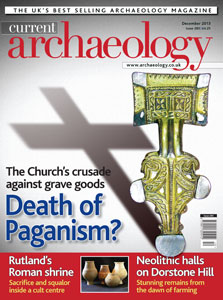The Early Anglo-Saxon tradition of burying the dead in their finery has bequeathed some of Britain’s most spectacular archaeology, from the regal splendour of Sutton Hoo to cemeteries laden with individuals wearing jewellery or weapons. But how did this practice die out? For many years it was believed to have gradually faded away, with little interference from the Christian Church. Now a major project has redated Early England and rewritten the story. Instead of experiencing a drawn-out decline, furnished burial appears to have been abruptly stamped out by a single Archbishop of Canterbury.
Fascinating insights into religious activity have also been provided by a Roman shrine discovered in Rutland. Inside, discarded animal parts were left decaying on the floor alongside scattered treasures and a curse tablet. The ruined shrine became a tomb in the Anglo-Saxon period, when a shallow grave was dug within its walls.
Another case of works for the living ending up as receptacles for the dead has been encountered in Herefordshire. Here, two monumental Neolithic halls were put to the torch and recycled as burial mounds. As well as the remains allowing a unique glimpse of the halls’ appearance, their funerary role hints at how a founding Neolithic community was venerated by their descendants.
Finally, Alan Sorrell’s much-loved archaeological artistry is being showcased in a new exhibition. We explore the work of a self proclaimed ‘artist, and not an archaeologist’, while Alan’s daughter reveals how a moment of boredom led to a heritage revolution.
FEATURES/n
REDATING EARLY ENGLAND/n
Explaining the end of Anglo-Saxon pre-Christian funerary traditions
A major survey of almost 600 Early Medieval graves has revealed that furnished burial stopped earlier, and more abruptly, than previously thought.
ENSHRINED BY CONSERVATION/n
A Romano-British shrine in Rutland Water
Archaeological work ahead of the creation of a new wildlife habitat has uncovered the a well-preserved circular structure. What can this enigmatic building tell us about Roman cult practice?
DORSTONE HILL/n
How halls for the living became homes for the dead in Herefordshire
Initially interpreted as a Neolithic causewayed enclosure, these Herefordshire earthworks have revealed something much more unusual: two 6,000 year old halls, transformed into tombs.
ALAN SORRELL/n
‘An artist, and not an archaeologist’
Drawing together the life and work of a pioneer in archaeological reconstruction illustrations.
NEWS/n
Opening Edwina’s box at Aldeburgh; Flood of finds from Cardiff Castle leat; Found: Richard III’s lost chapel; Bronze Age boat-builders in Monmouth?; Tracing Tredegar House; Maryport’s Roman retail; New light on the
New Forest; Revisiting Rathcroghan
/n
REGULARS/n
Opinion
The artist and the Wall: an exploration of Alan Sorrell’s work at Hadrian’s Wall, by his daughter Julia
Reviews
Dartmoor’s Alluring Uplands; Northumberland Churches; Ancestral Journeys; All that Matters: the Romans
Sherds
Chris Catling’s irreverent take on heritage issues
Last Word
Andrew Selkirk reminisces about a star find in the Medieval landscape ‚ and his own brush with television stardom
Odd Socs
The Naval Dockyards Society

